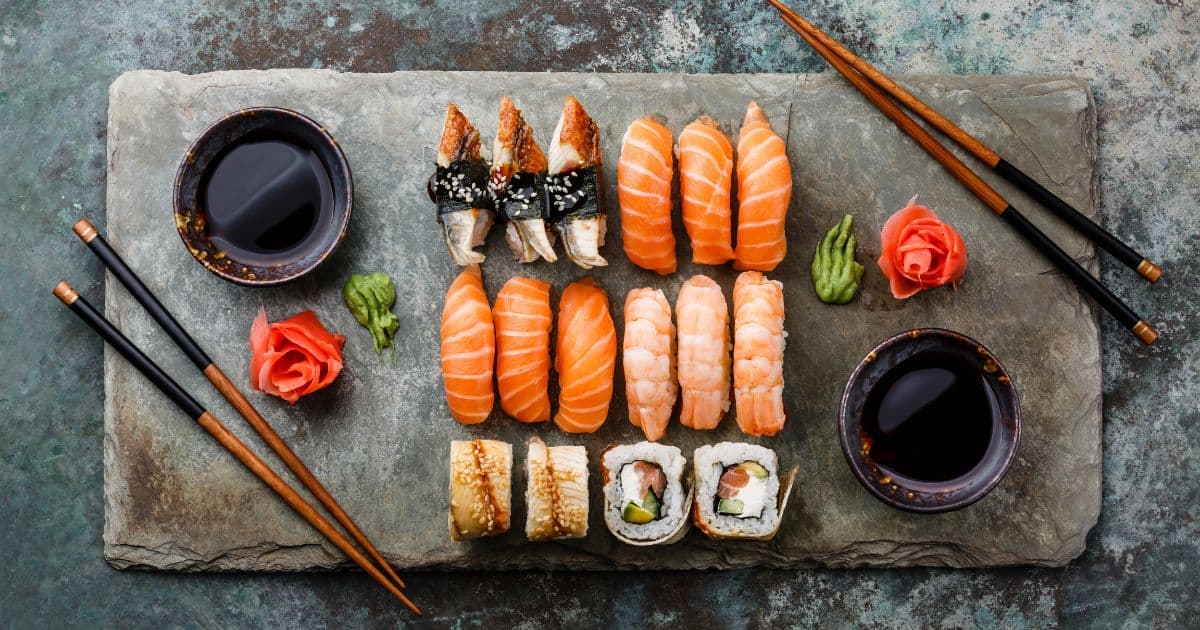Sushi has exploded in popularity over the last several decades.
This delicacy is full of omega-3 fatty acids and healthy protein.
However, many sushi rolls contain carb-rich sticky rice and are full of sugary sauces. This can be a recipe for a blood sugar disaster.
This article will explore the best sushi options for better blood sugar management if you live with diabetes.

Eating sushi if you have diabetes
If you’re wondering if you can eat sushi if you have diabetes, the answer is an enthusiastic yes!
Sushi has many health benefits and is a great meal, even if you’re counting carbohydrates and watching your blood sugar levels.
However, if you’re managing blood sugar levels, it is important to be wary of toppings, sauces, spicing, and the infamous sticky rice.
When you order sushi, it’s good to know what kinds of sushi will be easier on your blood sugar levels.
The health benefits of sushi
Sushi has many health benefits when ordered correctly.
A typical sushi meal consists of small balls or rolls of vinegar-flavored cold-cooked rice. It is garnished with raw or cooked fish, vegetables, or eggs.
Some sushi options may provide the following:
- Healthy source of protein from cooked and raw fish
- Vitamins and minerals
- Anti-inflammatory omega-3 fatty acids
- Antioxidants (often found in the green tea served with the meal)
- Fiber, especially in edamame
- Low-carb options available
What to watch out for when eating sushi if you have diabetes
Rice has a lot of carbohydrates
Even though people associate sushi with fish, the main course of any sushi meal is rice. The rice is often white or sticky rice, cold-cooked with vinegar.
White rice has a glycemic index (GI) of 64, with barely any fiber (1 gram or less), plus nearly 45 grams of carbohydrates.
It also doesn’t contain any of the vitamins or minerals that brown rice contains.
If you’re opting to eat rice, ask if the restaurant offers brown rice in their sushi rolls as a replacement for white rice. Otherwise, you may be in for a severe blood sugar spike.
The following rolls contain rice:
- Nigiri is a piece of fish or egg on top of flatly-pressed rice.
- Maki is a traditional sushi roll rolled up with dried seaweed.
- Tamaki is a hand roll that you eat whole.
- Uramaki has fish and seafood on the inside with an outer layer of sticky rice.
Sugary sauces
Traditional sushi and sashimi do not come with sugary sauces. While traditional soy sauce contains fewer than one gram of carbohydrates.
However, many sushi rolls come with added sugary sauces, such as ponzu sauce, eel sauce, and mirin sauce. Even pickled ginger contains added sugar and carbohydrates.
Most shockingly, wasabi contains over seven grams of carbohydrates per tablespoon!
Even adding a couple of tablespoons of these added sauces can make for a sugar bomb and a blood sugar disaster.
You can always ask for your rolls to be made without the added sauces, or get them on the side.
It’s ultimately best to avoid them altogether and stick with soy sauce or eat your sushi plain.
Greasy and fried fish
Greasy and deep-fried sushi rolls are called tempura. While they might be tasty, they are anything but healthy—especially if you live with diabetes!
Tempura batter is made with white flour and then deep-fried, usually in refined seed oil.
Greasy and fatty foods increase insulin resistance. This makes it harder to keep blood sugar levels within a healthy range, even hours after you’ve finished your meal.
Over time these greasy and fried options clog arteries, increase your risk for heart disease and stroke, and contribute to excess calorie consumption and weight gain.
It is best to choose raw or lightly cooked sushi rolls over tempura rolls.
What are the best options for sushi if you have diabetes
There are many different types of sushi to choose from.
The following are healthier options for blood sugar management when eating sushi:
Stick with sashimi
This is your best bet if you’re looking for a completely low-to-no-carb meal. Sashimi is simply thinly-sliced raw fish, all made without rice.
Often, the chef will spiral some daikon radish as a garnish that is also edible and delicious, especially with a slice of pickled ginger and a little soy sauce.
This makes for an incredibly high-protein, low-carb meal that can’t be beaten.
Hold the rice
Some restaurants now offer Naruto. This means they replace the rice and seaweed with thinly sliced cucumbers in their rolls.
You can also ask the restaurant to hold the rice and let them get creative with making rolls from daikon or ginger slices.
Finally, you can ask for rice to be on the side and carb count accordingly.
Always call ahead and ask if they’ll accommodate your requests ahead of time.
Opt for miso soup
Miso soup is a dish made from seaweed and miso—a fermented soybean paste—along with other vegetables added into the mix.
It is rich in key nutrients such as Vitamin K, manganese, zinc, protein, and calcium, which support bone and nervous system health.
Additionally, miso soup is a probiotic. This makes it an excellent aid for digestion and gut health.
Miso soup is also low in carbohydrates, making it the perfect addition to any meal.
Load up on Edamame
Edamame beans are simply steamed soybeans eaten right out of the pod.
This nutritional snack offers six grams of protein and three grams of dietary fiber per serving. Edamame only has four total carbohydrates (one net carbohydrate).
They are usually eaten with a little sea salt and are never fried. Edamame is a great option as a side dish to amp up the nutritional profile of your meal.
Drink green tea
Green tea is the traditional beverage served with any Japanese meal—and for good reason! It is full of healthy antioxidants and anti-inflammatory properties.
It is usually consumed unsweetened, so there will never be added carbohydrates, sugars, or even artificial sugars in your drink.
Green tea lowers the risk of heart disease, type 2 diabetes, and even some cancers.
If you choose to imbibe:
Saké, a Japanese rice wine, is considered a low-carb option with only five grams of carbohydrates per serving. This is due to the fermentation process the wine goes through.
Sapporo beer, the traditional Japanese beer, has more carbohydrates with 10 per serving.
Do I have to take insulin for sushi?
This all depends on your insulin and carbohydrate sensitivity, as well as what type of sushi you’re eating.
Sashimi has no carbohydrates. While edamame and miso soup have only a few.
However, you may need to take insulin for carb-rich options like tempura rolls or rolls made with sticky rice.
Work with your doctor or certified diabetes educator (CDE) to figure out your insulin to carbohydrate settings and answer questions about eating sushi.
How to incorporate sushi into your diet
Remember the following if you’re incorporating sushi into your diet:
- Stick with sashimi or Naruto if you’re looking for low-carbohydrate options.
- Eat plenty of miso soup and edamame to bulk up your meal with nutrients without the added carbohydrates.
- Drink plenty of green tea or water (saké is fine, too.)
- Ask for rice on the side.
- Count all carbohydrates, and be wary of sticky rice and added sugary sauces.
- Take your insulin and/or diabetes medications as prescribed.
- Ask for rolls to be made without sauces or on the side.
- Don’t stress! One meal won’t ruin your diabetes management.



